![]()
![]()
![]()
Use LEFT and RIGHT arrow keys to navigate between flashcards;
Use UP and DOWN arrow keys to flip the card;
H to show hint;
A reads text to speech;
159 Cards in this Set
- Front
- Back
- 3rd side (hint)
|
Asexual reproduction types |
1.mitosis 2.budding 3.fragmentation 4.tissue grafts |
|
|
|
Asexual reproduction definition |
genetically the same individual. no changes to genome |
|
|
|
Gene |
smallest unit of heredity, region of DNA that controls a specific heretic characteristic |
|
|
|
Genome |
all the DNA in an organism coding and non coding information. carries the code to make more. Located inside of the nucleus |
|
|
|
Contrast Asexual reproduction with sexual reproduction |
Asexual - identically similar DNA Sexual - genetically different offspring |
|
|
|
mitotic spindle components |
Astral - anchor Polar Spindle fiber - attach to chromosomes centriole - occurs in pairs involved in the development of spindle fibers |
|
|
|
kinetochore |
is a protein structure on chromatids where spindle fibers attach during cell division to pull sister chromatids apart. Their proteins help to hold the sister chromatids together. |
|
|
|
how are chromosomes manipulated |
the centrosomes produce centrioles that then produce polar spindal fibers that attach and former the mitotic spindle apparatus. Astrals act as anchor |
|
|
|
how many chromosomes do humans have |
a pair of 23 |
|
|
|
autosome |
first 22 pair of chromosomes |
|
|
|
sex chromosome |
23rd chromosome determines gender identity female - XX male - XY |
|
|
|
define chromatin |
spread out DNA. toilet paper on the floor analagy |
|
|
|
Cell Cycle includes |
Intephase (70-85%) -G1 phase -S phase -G2 phase Mitosis (15-30%) - Prophase - Prometaphase - Metaphase - Anaphase - Cytokinesis |
|
|
|
what happens in the G1 phase |
prepares for a secondary cell by making more organelles and cytoplasm than needed. |
|
|
|
what happens in the S phase |
synthesis of DNA. go from 46 chromosomes to 92. |
|
|
|
what happens in the G2 phase |
all cell structures in cell division are produced. occurs right before mitotic spindle apparatus |
|
|
|
Mitosis: Prophase |
chromatin condenses into chromosomes mitotic spindle apparatus start to format from the centrosomes |
|
|
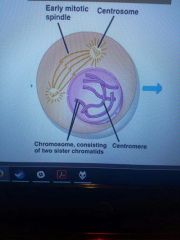
name this stage |
Prophase chromatin condenses to chromosomes mitotic spindal apparatuses form from centrosomes |
|
|
|
Mitosis: Prometaphase |
distinguishes b/w pro and eukaryotes nuclear membrane breaks down spindle fibers attach to chromosomes at the centromere |
|
|
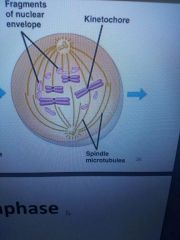
|
Prometaphase nuclear envelope disappears spindle fibers attach to chromosomes at the centromere |
|
|
|
Mitosis: Metaphase |
chromosomes align on metaplate chromosome fibers align |
|
|

|
Metaphase align on plate chromosomes align |
|
|
|
Mitosis: Anaphase |
Centromeres disappear 92 chromosomes seperate and come together at the centrioles |
|
|
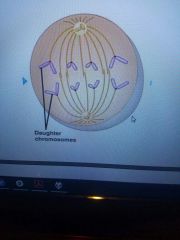
|
Anaphase centromeres disappear 92 chromosomes seperate and come together |
|
|
|
Mitosis: Telophase |
reverse previous steps. -nuclear membrane repairs -chromosomes are now chromatin -spindles disappear |
|
|
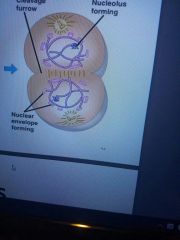
|
Telophase nuclear membrane repairs chromosomes are now chromatin spindles disappear |
|
|
|
Cytokinesis |
Splits into 2 creates clevage |
|
|
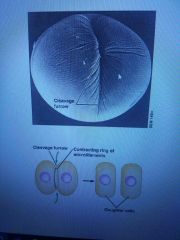
|
Cytokinesis Splits into 2 |
|
|
|
Cytokinesis within plants |
Imbedded in cellulose creates another cell wall |
|
|
|
difference between mitosis and meiosis |
meiosis - reproduction mitosis - growth and repair |
|
|
|
meiosis fxn |
splits normal chromosomal number |
|
|
|
human haploid number |
46 |
|
|
|
human diploid number |
23 |
|
|
|
meiosis interphase |
same as mitosis 2n = 46 |
|
|
|
Meiosis Prophase |
very similar to mitosis, -chromatin condenses -nuclosis dissolves -spindal form
Differences - Synapsis occurs - crossing over 2n=46 |
|
|
|
Synapsis Meiosis |
tetrads find each other binds with same chromosome number |
|
|
|
crossing over |
Crossing over creates genetic diversity. when chromosome literally crosses over sister chromatids. exchanges genetic material after crossing over |
|
|
|
Meiosis Metaphase 1 |
2n=46 tetrads line up on Metaphase plate to be pulled apart from sister tetrad. by the myotic spindle apparatus. |
|
|
|
Meiosis Anaphase 1 |
Homologs sister chromatin are pulled appartment to opposite sides of cell cutting plody on half 2n=23 |
|
|
|
Meiosis Telophase 1 |
reverses the steps of Prophase and Metaphase. n=23 |
|
|
|
Cytokinesis 1 |
fill in answers |
|
|
|
Meiosis II |
mitosis for a pair of haploid (n=23) daughter cells No "S" phase in meiosis ( do not want synthesis to occur after meiosis has already archived it |
|
|
|
Meiosis II Prophase II |
same as pro phase 1, but no crossing over, and no synapsis. |
|
|
|
Meiosis II Metaphase II |
chromatin line the Metaphase plate and attach spindle apparatus fibers |
|
|
|
Meiosis II Anaphase |
pull chromatin apart |
|
|
|
Meiosis II Telophase II |
reverse previous steps.-nuclear membrane repairs-chromosomes are now chromatin -spindles disappear |
|
|
|
Fertilization |
2 gamiets, 2 (n23) form a zygote n=46 |
|
|
|
independent orientation |
53:20 (need to go back over) |
|
|
|
Explain how mitosis conserves chromosome number while meiosis reduces the number from diploid to haploid |
mitosis is for growth and repair needing the same number of chromosomes to replicate meiosis goes to haploid because 2 gamiets need to come together to create a zygote with a diploid number 2n=23. |
|
|
|
monozygotic |
1 zygote (identical twins) |
|
|
|
dizygoytic |
2 zygote (fraternal) |
|
|
|
fill in this chart |

|
|
|
|
photosynthesis Latin roots |
photo-light synthesis- dark reaction (Calvin cycle) |
|
|
|
photosynthesis |
an end endergonic reaction (products are more reactive than reactants
Light + ATP + CO2 +H20 = C6H12O6 +O2 occurs in chloroplast in plant cells |
|
|
|
Autotroph |
Self feeding, make their own Energy Photoautotroph Chemiautotroph |
|
|
|
Heterotroph |
requires organic molecules from other organisms |
|
|
|
What do autotroph require from the environment in order to make their own food |
-CO2 -liquid water -Energy |
|
|
|
Stromata |
pours within the leaves that allow the passing of CO2 in the plant and O2 as waist. also allows water to be absorbed or expelled. |
|
|
|
Roots |
hydrotrophisim - Roots grow towards water source. another way plants intake water to make ATP |
|
|
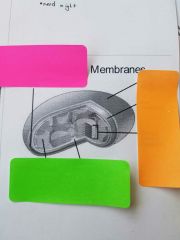
name the parts |
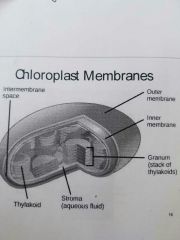
|
|
|
|
in photosynthesis what is reduced |
CO2 is reduced to C6H12O6 (Gains Hydrogen) |
|
|
|
in photosynthesis what is oxydized |
H20 (loses H) |
|
|
|
Which redox process,photosynthesis or cellular respiration, is endergonic? |
photosynthesis is endergonic because it's products are more reactive than the reactants |
|
|
|
thylakoid |
1 disk in a stack of Grana |
|
|
|
Grana |
a stack of thylakoid. many stacks are called granum |
|
|
|
Stroma |
the extracellular fluid in chloroplasts |
|
|
|
Properties of light |
-Reflection -Transmission -Absorption -Florescence |
|
|
|
Pigments |
-Chlorophyll b -Chlorophyll a -Beta Carotine -Phycoerythrin -Phycocyanin -Zantifield (SP) |
|
|
|
what properties of light is most important for photosynthesis |
Absorption |
|
|
|
what is the most common enzyme on planet earth |
Rubisco |
|
|
|
how is breathing related to cellular respiration |
intake O2 and waste is CO2 |
|
|
|
Reactants |
the first part of an equation |
|
|
|
products |
the final part of the equation |
|
|
|
Why is H+ called a Proton |
because an electron has been stripped from the atom, it is a Hydrogen ion |
|
|
|
How does an Acid become an -ATE |
When a Hydrogen ion is added to it |
|
|
|
Oxidation-Reduction reactions |
LEO the lion says GER Loss of e- is oxidation LEO Gain of e- is reduction GER |
|
|
|
C6H12O6 + 6O2 -> 6CO2 + 6H2O + ATP + heat reactant is being oxidized, reduced? |
C6H12O6 is being oxidized (loses the e-) 6O2 is being reduced (Gains the e-) |
|
|
|
What chemical characteristic of element Oxygen accounts for its fxn in cellular respiration? |
Oxygen electrogavity allows it to |
|
|
|
Substrate level phosphorylation |
the use of an enzyme to make ATP |
|
|
|
Oxidative Phosphorylation |
addition of an inorganic phosphate |
|
|
|
NADH |
Nicotinamide adenine dinucliotide Dumptruck full of batteries NADH is oxidized to form NAD+ NAD+ is reduced to form NADH |
|
|
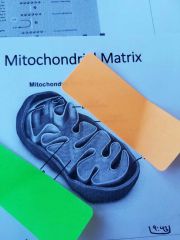
|
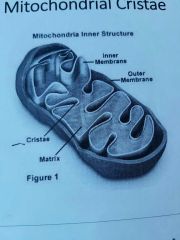
|
|
|
|
Location and stages of the metabolic path way of glycolysis |
Glycolysis --- Cytoplasm of the cell Citric acid cycle--- Mitochondrial matrix Electron transport (OP) --- Mitochondrial cristae |
|
|
|
what does CO2 do to the body |
makes the body acidic |
|
|
|
Glycolysis summary |
Inputs - Glucose and ATP Outputs - (2) pyruvate, (4)ATP, (2)NADH |
|
|
|
oxidation bonds |
ionic |
|
|
|
how many phosphorylation do we know of |
oxidative phosphorylation substrate level phosphorylation photo phosphorylation |
|
|
|
reduction bonds |
ionic |
|
|
|
NADH |
Nicotinamide amide adenine dinucliotide, Dumptruck full of batteries. NAD+ is oxidized to create NADH |
|
|
|
Glucose is oxidized to form ? |
CO2. an exothermic reaction |
|
|
|
oxygen is reduced to form |
H2O in an exothermic reaction |
|
|
|
what chemical characteristic of the element Oxygen accounts for its fxn in cellular respiration |
Oxygen's electrogavity allows it to be the final e- acceptor in the e- transport chain |
|
|
|
what is an organic molecule? |
a molecule that contains Carbon |
|
|
|
of the three main stages of cellular respiration which one uses oxygen to extract chemical energy from organic compounds |
oxidative phosphorylation |
|
|
|
is oxygen necessary during glycolysis |
no, oxygen is used during the crew cycle to pick up carbon and during chemiosmosis to pick up the loose e- |
|
|
|
Inputs of Glycolysis |
ATP Glucose |
|
|
|
Outputs of Glycolysis |
Pyruvate ATP NADH |
|
|
|
what is the most common metabolic pathway on the planet |
Glycolysis |
|
|
|
What differentiates pyruvate from either the citric acid cycle or fermentation |
Oxygen w/ -> citric acid cycle (aerobic) w/o-> fermentation (anaerobic) |
|
|
|
Advantages and disadvantages of fermentation |
A- occurs w/o oxygen D- inefficient ~1-2% |
|
|
|
what is acetyl CoA derived from? |
fats carbs and lipids |
|
|
|
what breaks down Acetyl CoA |
Coenzyme A |
|
|
|
how many parts are oxidative phosphorylation |
1.electron transport chain 2. chemiosmosis |
|
|
|
what is generated during the Krebs cycle? |
NADH, FADH2, ATP, and CO2 as waist |
|
|
|
what is the e- purpose during the electronic transport train? |
The e-'s purpose is to power the active transport proteins, that take H+ across the biological membrane to create a concentration gradient. Oxygen then picks up the loose e- |
|
|
|
Chemiosmosis |
High concentration gradient of H+ ATP synthesis allows the H+ to cross back over the membrane and takes ADP to ATP via oxidative phosphorylation |
|
|
|
what is the difference b/w NADH and FADH2 |
where they are produced FADH2 is only produced in the creb cycle while NADH is produced in both in glycolysis and the creb cycle. |
|
|
|
chemiosmosis as the final step, explain it all |
Chemiosmosis drives oxidative phosphorylation. Oxidative phosphorylation is made up of chemiosmosis and the e- transport chain. e- come from the oxidized NADH, FADH2 through Glycolysis and the creb cycle. the e- drives the active transport proteins chain to create a concentration gradient of H+ ions. The gradient then allows H+ ions back trough through ATP synthesis to create ATP via oxidative phosphorylation. |
|
|
|
How do the reactants molecules of photosynthesis reach the chloroplast in leaves? |
stromata |
what are the reactants |
|
|
What is the entercellular fluid of chloroplasts? |
Stroma |
|
|
|
of the reactants in photosynthesis what is oxidized, which is reduced |
C02 is reduced, gains a H+ and the product is glucose H2O is oxidized, it looses H+ and the product is O2 |
|
|
|
where are the photosystems located |
the bilipid membrane of the thylakoid |
|
|
|
what are photosystems made of? |
protein based structures |
|
|
|
what is the fxn of a pigment? |
it allows the transmittance of a photon of light to Chlorophyll |
|
|
|
what enzyme splits water |
dehydrogenase |
|
|
|
main differences between photosystem 1 and 2 |
2's main goal is to produce ATP 1's main goal is to produce NADPH |
|
|
|
products of a light dependent reaction |
NADPH, ATP, O2 |
|
|
|
what is needed for chloroplast to create CO2 in the dark? |
ATP & NADPH |
|
|
|
name the most common, abundant, enzyme on the earth |
Rubisco, which is involved with the first step of the Calvin Cycle |
|
|
|
Calvin Cycle consist of how many phases |
3. Carbon fixation, Reduction phase, and Regeneration |
|
|
|
Reactants in the Calvin Cycle |
CO2 ADP NADH ribulos biphosphate |
|
|
|
During the regeneration phase where do the remaining G3P go? |
the cell uses it -converting it into sugar -uses it for cellular respiration -creating cellulose (structural) -starch (energy) |
|
|
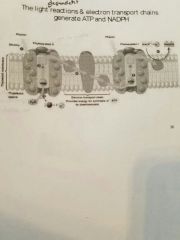
explain the path. from photon to end result |
photon strikes the photosystems in the thylakoid membrane traveling along pigment molecules until it is picked up by a a Chlorophyll molecule where it excites an e- molecule from the splitting of water. it then rises to a higher energy state in the reaction center. it then moves to the primary electron acceptor creating ATP, and starting the first step in creating a concentration gradient. it then moves to photosystem 1 where once again a photon of light strikes and allows the excitement of e- pumping H+ through the membrane. NADP+ picks up the e- in an oxidation reaction. and moves it to the Calvin Cycle. the concentration gradient is still there where ATP synthase binds ADP and an inorganic phosphate creating ATP. where we then enter the Calvin Cycle Carbon fixation |
|
|
|
where does the carbon cycle reactions occure |
the Stroma of the chlorplast |
|
|
|
when does independent occure? |
between Metaphase and Anaphase |
|
|
|
what is blending |
offspring shade of color will blend together |
|
|
|
Heredity |
transmission of traits from one generation to the next |
|
|
|
Genetics |
the study of heredity |
|
|
|
charachter |
habitable features that very from individuals AKA flower color |
|
|
|
Trait |
The specifics AKA the red flower |
|
|
|
alleles |
a pair of genes |
|
|
|
locus |
the location on the chromosome where the alleles are found |
|
|
|
homozygous |
Same alleles, DD or DD |
|
|
|
heterozygous |
different alleles Dd |
|
|
|
Phenotype |
expression of physical trait, characteristics derived from genetics |
|
|
|
Dominant |
expressed as capital letters trait is always expressed |
|
|
|
Recessive |
expressed as lowercase letters, not always expressed only expressed when both traits are recessive |
|
|
|
The law of Segregation AKA Mendle's First law has 4 parts |
1 Alleles 2 For each character an organism inherits two alleles one from each parent 3 Dominate and recessive 4 Law of Segregation |
|
|
|
Variation of Mendle's Law |
- Incomplete dominance - Multiple alleles - Co-domimance - Pleiopthropy (multiple traits) - Polygenic Inheritance (many genes contribute for one outcome) - Gene linkage (closer alleles are to each other less likely they'll seperate |
|
|
|
what is the unifying property of all life on the planet |
DNA |
|
|
|
Components of DNA |
Sugar, (structure) Phosphate group, Nitrogen bases -adenine=thymine -guanine=_cytocine A&G - single ring structure T&C - double ring structure |
|
|
|
anti parallel |
5' pairs with 3' because of space |
|
|
|
what are the bonds that hold the sugar backbone of DNA called |
polar covalent bonds |
|
|
|
How are the nitrogenous bases held together? |
Hydrogen bonds |
|
|
|
what is the process called when binding 1 nucleotide via another with polar covalent bonds? |
dehydration reaction |
|
|
|
What is necessary for DNA replication to occure |
enzymes |
|
|
|
name the enzymes that are responsible for DNA replication |
DNA Polymerase, DNA Ligase, DNA Heliocase, DNA Primase |
|
|
|
DNA Polymerase |
builds DNA molecules 3' > 5' |
|
|
|
DNA Lygase |
heals the DNA strand |
|
|
|
DNA Replication steps |
8 steps -DNA Heliocase unwinds and separates the hydrogen bonds between nucleotides -protein are placed to prevent the hydrogen bonds from forming again - short stretches of RNA on DNA template via Primase - Polymerase adds DNA nucleotides to RNA primer - Polymerase does a proof reading activity, replaces in correct bases - continuous new strand 5'-3' manner while daughter is 3'-5' discontinuous manner creating okizaki fragments - enzymes remove bonding and allows bonding (DNA Lygase) |
|
|
|
mutation |
alteration of normal sequence of nucleotides in a DNA strand |
|
|
|
When is the diploid number 2n=92 |
S phase |
|
|
|
Transcription |
DNA-RNA Identical copy |
|
|
|
Translation |
RNA -Protein transfer of information from 1 macromolecule to another |
|
|
|
Where does Transcription occure |
Nucleus of the cell |
|
|
|
Where does Translation occure? |
Cytoplasm of the cell |
|
|
|
RNA nucleotides |
Adenine Uracel cytocine guanine |
|
|
|
Types of RNA |
mRNA (messenger) tRNA (transfer) rRNA (Ribosomal) |
|
|
|
codeon |
3 nucliotides |
|

